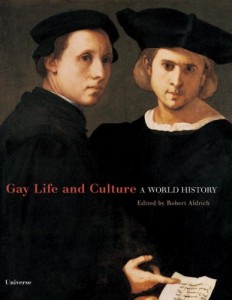 Gay Life and Culture: A World History
Gay Life and Culture: A World History
Edited by Robert Aldrich
Universe, 384 pages, $49.95
THIRTY, even twenty, years ago, a book titled Gay Life and Culture: A World History would have been unachievable because much of the research needed to produce such a work did not yet exist. Forty or fifty years ago, such a book would have been unthinkable because “gay” and “lesbian” as historical and cultural concepts were not around, at least as topics of academic pursuit. What a difference a few decades makes, and it’s a difference that’s largely due to the work of lesbians and gay men, along with our allies from the bisexual, transgender, and transsexual communities.
Gay Life and Culture is not exactly a culmination of the GLBT cultural revolution that has occurred over the last few decades, but it marks an important milestone. Editor Robert Aldrich, Professor of European History at the University of Sydney in Australia, has brought together fourteen essays by scholars from nine countries writing on topics spanning a wide range of lesbian and gay history: homosexuality in ancient Greece and Rome, in Europe’s Middle Ages, Renaissance, Enlightenment, and early modern periods; attitudes toward same-sex behavior in America from colonial (and even pre-colonial) times to the 20th century; cross-cultural comparisons of attitudes and practices relating to same-sex behavior in pre-Columbian North and South America, sub-Saharan Africa, Polynesia, and the indigenous population of Australia; homosexuality in the Middle East and North Africa; same-sex intimacy in Asia; lesbian life in early modern Europe and the modern world; lesbian and gay politics since World War II; and the gay world from 1980 to the present.
The book, lavishly illustrated with 200 color and black-and-white reproductions of paintings, drawings, sculpture, pottery, photos, and movie stills from all over the world, makes several important points. First, in our contemporary world, where large parts of the population still view homosexuality as alien to “normal” life and love, it shows that same-sex sexual behavior has occurred at all times and places in human history. In the opening essay, Aldrich writes: “Since time immemorial and throughout the world, some men and women have felt a desire for emotional and physical intimacy with those of the same sex. Men have lusted after and loved other men; women have lusted after and loved other women.”
Second, the book shows that such desires have had differing social significance and repercussions in different cultures. In a society like ours where gays in the military, same-sex marriage, and pedophilia are (to varying degrees) hot-button issues, it may come as a surprise to many people that male homosexual relationships were prized and fostered in such militaristic societies as ancient Sparta and in Japan’s samurai warrior culture. Marriage between two men or two women was acceptable under certain circumstances in some Native American and African societies. And not only were boy-wives an accepted institution among some indigenous Melanesian and Australian cultures, but intergenerational homosexual sex was considered an important part of a young man’s maturation process.
These practices, so different from those of our society, sprang from attitudes toward sexuality and gender that in turn differed radically from our own. And this brings us to a third important point made by Aldrich: not only modern lesbian and gay identities as we know them, but the whole notion of a division between homo- and heterosexual that’s so ingrained in our thinking, is culture-specific rather than universal. The historical developments leading to these categories that we think of as natural are only now being unraveled. Indeed we can see evidence of cultural change at work in our own time with the emergence or redefinition of categories such as “queer” and “transgender” just over the past few decades.
This is not Robert Aldrich’s first foray into gay history and culture. He co-edited (along with Garry Witherspoon) the dual volumes Who’s Who in Gay and Lesbian History: From Antiquity to World War II and Who’s Who in Contemporary Gay and Lesbian History: From World War II to the Present (both published in 2001). His The Seduction of the Mediterranean: Writing, Art, and Homosexual Fantasy (1993) is a thoughtful, highly entertaining look at the importance of Mediterranean culture, history, and myths in the work of some of the seminal figures in modern gay male culture. And his Colonialism and Homosexuality (2003) is a fascinating (if in part somewhat speculative) account of the role played by gay men in the European colonial expansion into Asia, Africa, North Africa, and the South Pacific.
Gay Life and Culture is an informative and well-written volume, a welcome addition to the growing body of literature that’s gradually mapping out the long-suppressed history of GLBT experience on this planet. It lacks a master bibliography, but each chapter is fully annotated at the end of the book for readers interested in pursuing any of the many lines of research that Aldrich sets forth.





